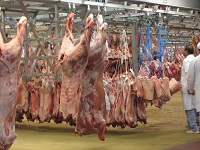We are on the bus at 2:00am sharp. Probably going out for dinner, drinking lots of wine and getting home at 11:00 was not the best strategy….but after a short nap, I was up and ready to go. This is Paris after all; I don’t want to waste any time sleeping!
We are headed to the Rungis – Paris’ wholesale food market. Normally it is closed to the public, but we are getting a guided tour from Professor Chemla, Director of Geography at L’Universite de la Sorbonne. His speciality is international wholesale food markets, and when asked how long he has been coming here – he tells us that he was practically born at Rungis. This is what I have been waiting for. This is my Herve This – what put me over the edge and made me want to come to Les Hautes Etudes de Gout.
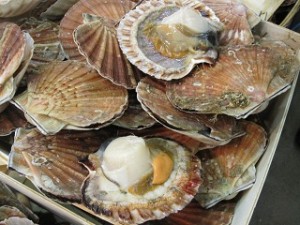
First stop is the poissonerie pavillion. It is 2:30am and the place is hopping. M. Chemla explains that the fishing boats reach the ports in the afternoon, where the seafood is quickly unloaded and driven to Rungis. The wholesalers set up their stands and are ready for business by 1:00am. The place is the size of three football fields, is immaculately clean, and has no odour of fish – but instead smells pleasantly of the fresh sea breezes. Almost all of the product on the floor was brought to port less than 10 hours ago, and will be sold by 4:00am.
The seafood is literally sparkling, and the variety is breathtaking.
Scallops. Brittany Lobsters. (We are told how superior they are to the Canadian variety) Sardines – shiny with gorgeous clear eyes. Rouget. Tuna. Sole. Plaice. We even spot a whole rare Grouper that had sold for 250 Euros. Live shrimp of all sizes, including tiny ones that are covered with paper, lest they jump all over the shop floor. Crab. Cases are piled high – some with tails sticking out of one end. We spot a shark. Sea urchin. Abalone. Prof Chemla picks up an eel….I think the early hour and lack of sleep is getting to me as I swear I see it move and then he declares “Voila! This one is still alive!!!”
Buyers interact with wholesalers, and their purchases are piled up on skids and dollies. Some of Paris’ finest restaurateurs are here, ensuring they get the freshest catch, the best varieties. Shopkeepers are here, some from independents, some from smaller chains – all wanting their product quickly so they can drive back into the city and have their shops ready for business by 8 or 9 am.
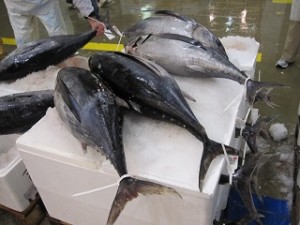
Rungis has been in existence in one form or another since the 1100’s, and was originally known as Les Halles. It has had many homes, including Ile de la Cite, but has been on this site on the outskirts of Paris since 1969. Rungis is the world’s largest market of its kind – it employs 17,000 people and covers over 200 hectares. It is incredibly well planned – the rail line comes right into the centre of the complex to allow easiest distribution. Rungis creates waste the equivalent to the city of 40,000 people – but almost all of the cases and cartons can either be recycled or incinerated on site – with the heat from the incinerator being exchanged to fuel the cooling of the many temperature controlled pavilions.
We visit the poultry pavilion, and despite the early hour and the abundance of various raw chickens, ducks, geese etc…we paw at the skids and skids of foie gras, drooling.
“These are too large” professor Chemla tells us as an aside “any liver over 650g has not been raised properly. Always buy your whole livers between 600 and 650g – the perfect size”
Got it. Will be sure to check the next time I buy my whole foie gras.
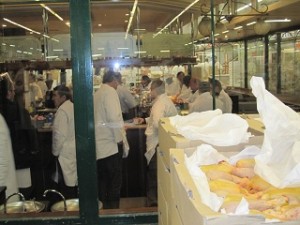
In the centre of the poultry hall (like most of the halls) there is a café. It is packed with workers, enjoying – at 4:30am- coffee, croissant, beer, wine ….and I do see one staff members uncorking a bottle of Champagne. How civilised. And apparently dangerous. We are told that in the past there have been accidents with workers taking their breaks with a few “pichets” of wine, only to return to work and badly cut themselves. But such is life – the workers need their breaks, they work hard, they want to have their wine!
As we enter the beef pavilion Professor Chemla tells us of the devastation of the Mad Cow era a few years back. The two beef pavilions were closed, all product destroyed, and the halls renovated – bringing them up to cutting edge food safety standards. There is a staff of veterinarians on site. We walk past incredible specimens – entire carcasses of beef, and lamb. The place is again spotless, with no odour whatsoever.
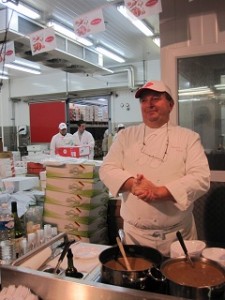
On to the “Triperie” which is the nice French way to say “offal”. I really did not want to go in. It was still very early and under great conditions I really do not have the stomach for offal. I forge ahead. Hearts. Tongue. Trotters. It’s all there. Nothing goes to waste. At the end of the hall – there is a stall serving tripe, and of course red wine. I have never been brave enough to try tripe, but decide that today is the day. Why not? It’s 5:30 am, we are all indulging, surrounded by calve’s heads and pig’s trotters, eating tripe and drinking wine.
On we go to one of the many produce halls. We are not really welcome there – they are setting up and we are getting in their way. “Ce n’est pas pour les tourists!!!” one man riding his bike from one end of the hall to the other yells as he tries to avoid all twenty of us. The freshness and the variety is gorgeous. Mushrooms. Cabbage. Apples. Pink Garlic. Endless lettuces. My favourite red and white striped radishes….
Next stop is the cheese. There are several skids of the first of the Vacherin Mont D’Or of the season. I want to order a case and take it with me on the bus. Wheels of Comte. Crates of delicate goat cheeses. The smell is heavenly.
Our final stop is breakfast. After five hours of walking the market we are famished. We stop at one of the many restaurants within the Rungis site, where workers are having breakfast, except it is more like dinner – huge steaks, pot au feu’s, blanquette de veau, and of course lots of red wine. We feast on cheeses, croissants, baguettes, ham, and above all coffee.
Without a doubt my favourite experience so far on this amazing adventure.
